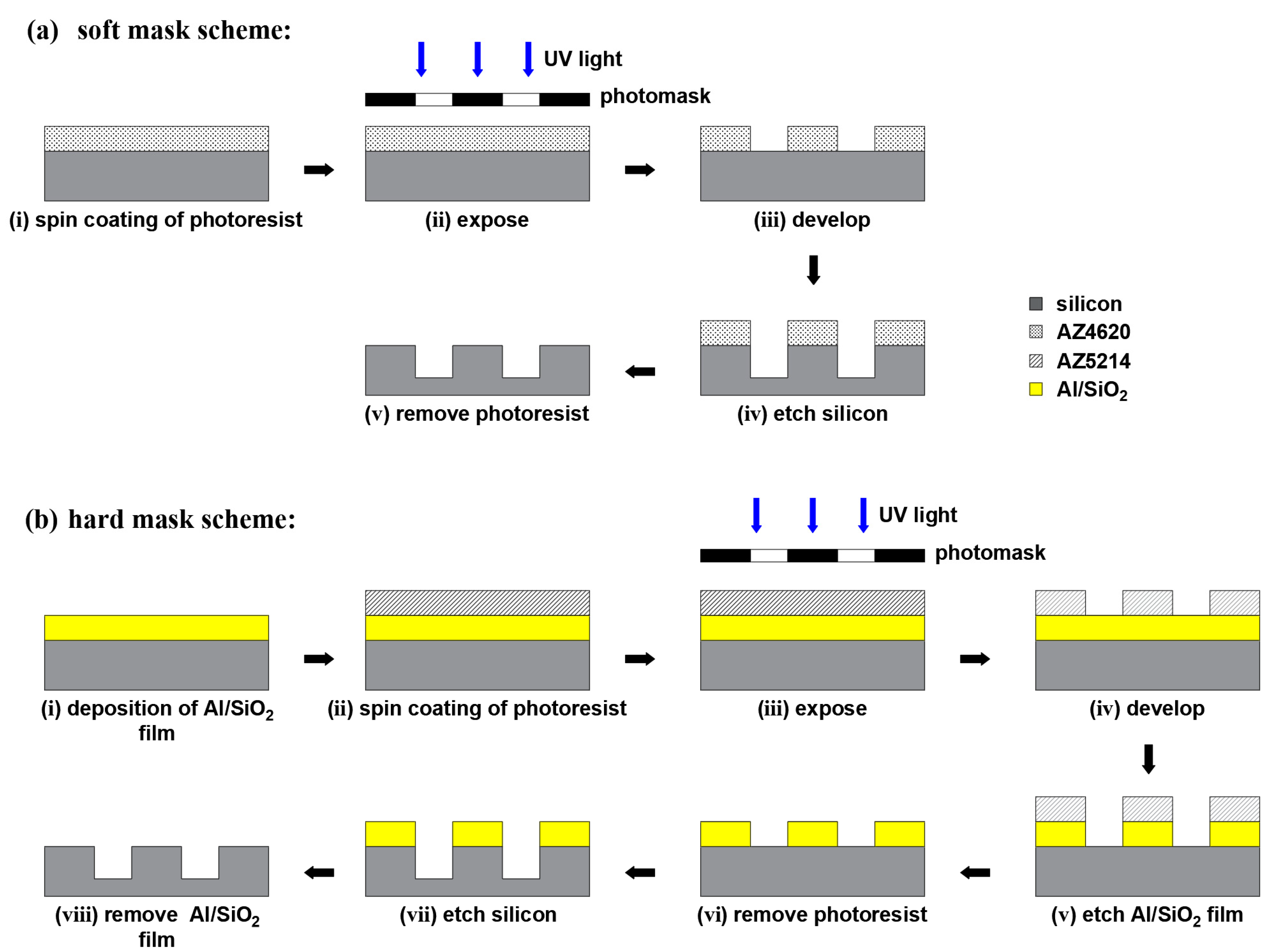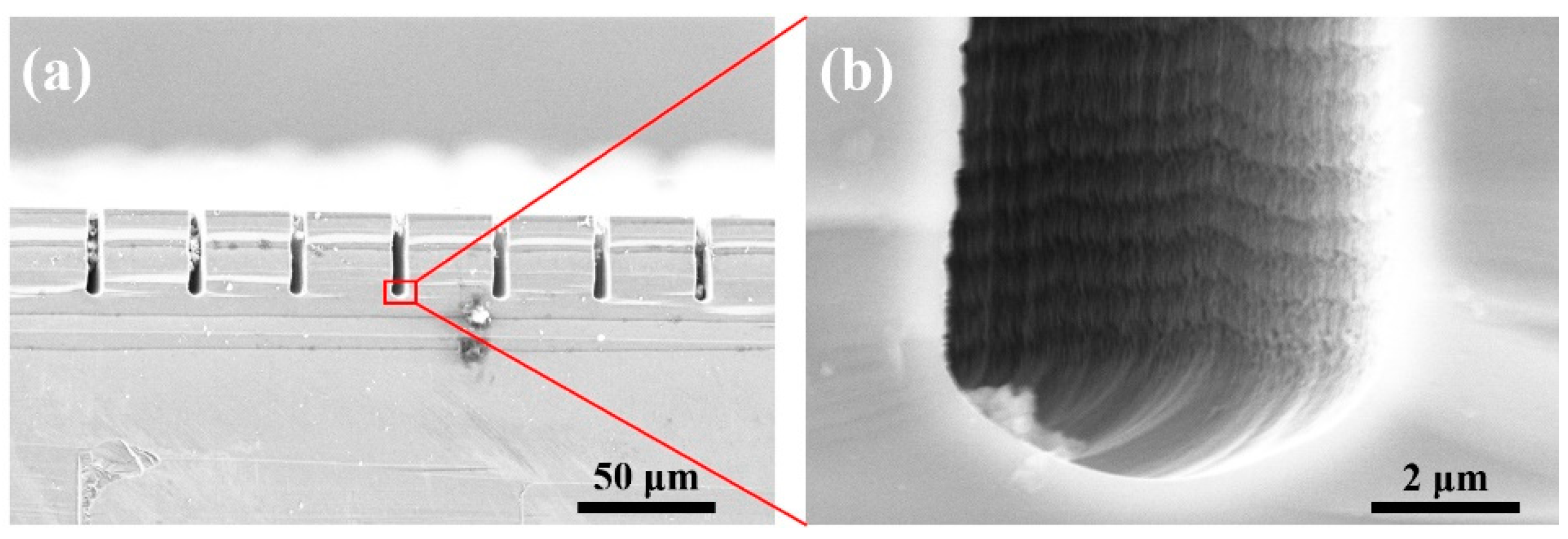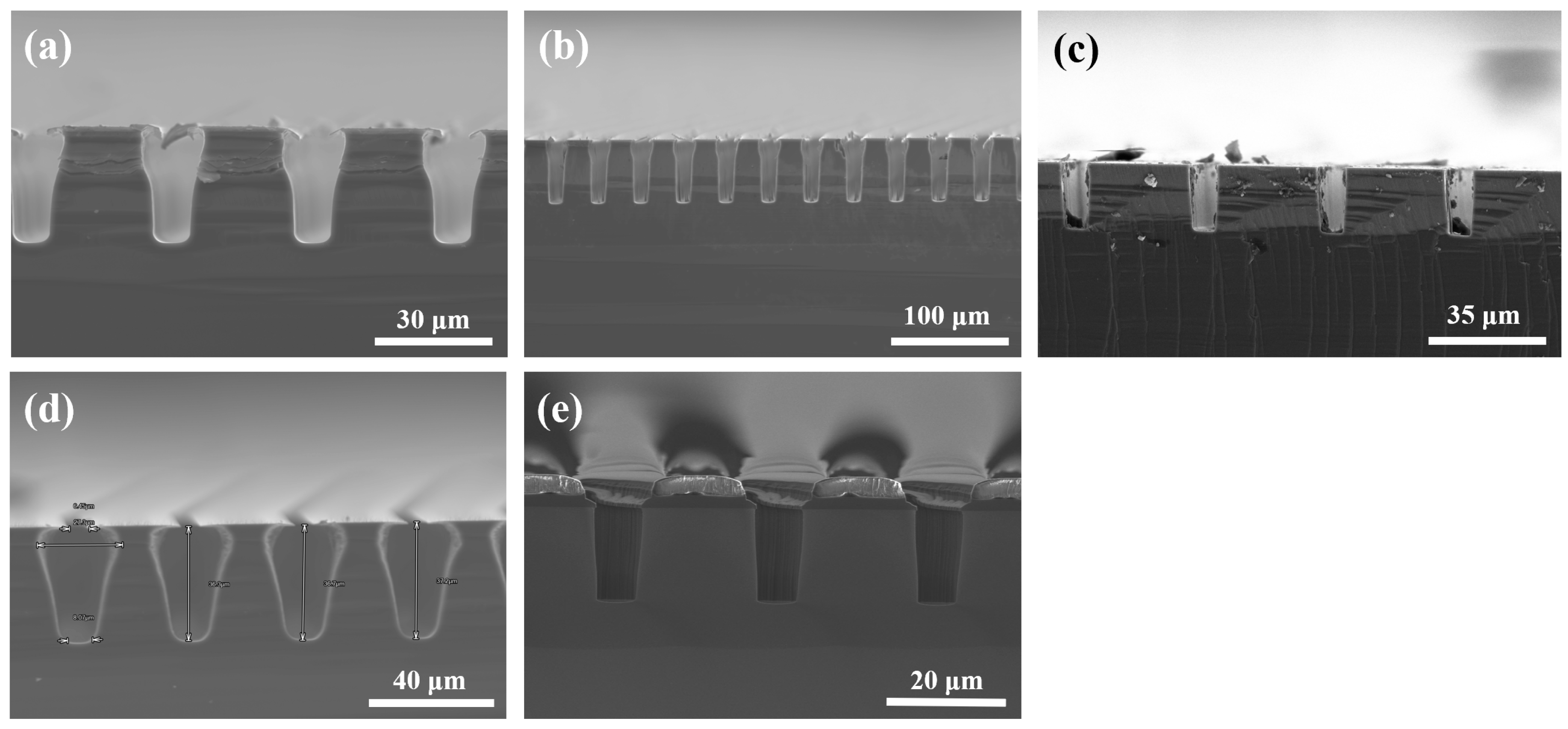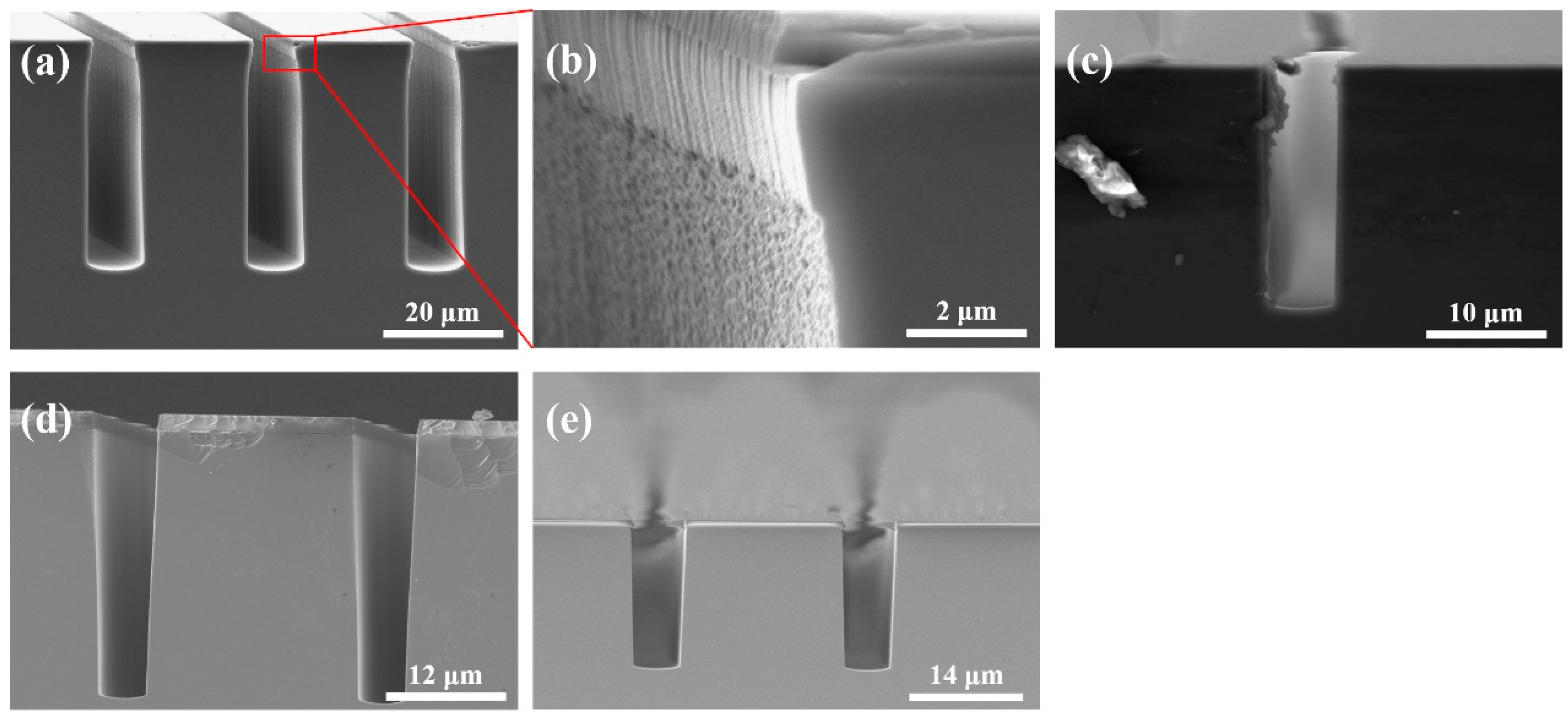Inductively Coupled Plasma Dry Etching of Silicon Deep Trenches with Extremely Vertical Smooth Sidewalls Used in Micro-Optical Gyroscopes
Abstract
:1. Introduction
2. Materials and Methods
2.1. Materials
2.2. Experimental Equipment
2.3. Methods
2.3.1. Geometry Design of MOG Waveguide Trenches
2.3.2. ICP Etching of MOG Spiral Trenches
2.4. Characterization
3. Results and Discussion
3.1. Bosch Process
3.2. Pseudo-Bosch Process
3.3. Cryogenic Etching
4. Conclusions
Author Contributions
Funding
Informed Consent Statement
Data Availability Statement
Conflicts of Interest
References
- Sanders, G.A.; Taranta, A.A.; Narayanan, C.; Fokoua, E.N.; Mousavi, S.A.; Strandjord, L.K.; Smiciklas, M.; Bradley, T.D.; Hayes, J.; Jasion, G.T.; et al. Hollow-core resonator fiber optic gyroscope using nodeless anti-resonant fiber. Opt. Lett. 2021, 46, 46–49. [Google Scholar] [CrossRef] [PubMed]
- Yan, J.; Miao, L.; Chen, M.; Huang, T.; Che, S.; Shu, X. Research on the feedback control characteristics and parameter optimization of closed-loop fiber optic gyroscope. Optik 2021, 229, 166298. [Google Scholar] [CrossRef]
- Shang, K.; Lei, M.; Xiang, Q.; Na, Y.; Zhang, L. Tactical-grade interferometric fiber optic gyroscope based on an integrated optical chip. Opt. Commun. 2021, 485, 126729. [Google Scholar] [CrossRef]
- Yang, L.; Zhao, S.; Geng, J.; Xue, B.; Zhang, Y. Sensitivity enhancement of micro-optical gyro with photonic crystal. Chin. Phys. B 2021, 30, 044208. [Google Scholar] [CrossRef]
- Arditty, H.J.; Lefevre, H.C. Sagnac effect in fiber gyroscopes. Opt. Lett. 1981, 6, 401–403. [Google Scholar] [CrossRef]
- Andronova, I.A.; Malykin, G.B. Physical problems of fiber gyroscopy based on the Sagnac effect. Physics-Uspekhi 2002, 45, 793. [Google Scholar] [CrossRef]
- Lin, S.C.; Giallorenzi, T.G. Sensitivity analysis of the Sagnac-effect optical-fiber ring interferometer. Appl. Opt. 1979, 18, 915–931. [Google Scholar] [CrossRef]
- Feng, Z.; He, Y.; Yan, W.; Yang, F.; Han, W.; Li, Z. Progress of waveguide ring resonators used in micro-optical gyroscopes. Photonics 2020, 7, 96. [Google Scholar] [CrossRef]
- Venediktov, V.Y.; Filatov, Y.V.; Shalymov, E.V. Passive ring resonator micro-optical gyroscopes. Quantum Electron. 2016, 46, 437. [Google Scholar] [CrossRef]
- Zhang, Y.; Geng, J.; Li, L.; Wang, Y.; Yang, L. Exceptional-point-enhanced Brillouin micro-optical gyroscope based on self-injection locking. Opt. Commun. 2023, 528, 129008. [Google Scholar] [CrossRef]
- Suzuki, K.; Takiguchi, K.; Hotate, K. Monolithically integrated resonator microoptic gyro on silica planar lightwave circuit. J. Lightwave Technol. 2000, 18, 66–72. [Google Scholar] [CrossRef]
- Mottier, P.; Pouteau, P. Solid state optical gyrometer integrated on silicon. Electron. Lett. 1997, 33, 1975–1977. [Google Scholar] [CrossRef]
- Yu, H.; Zhang, C.; Feng, L.; Hong, L. SiO2 waveguide resonator used in an integrated optical gyroscope. Chin. Phys. Lett. 2009, 26, 054210. [Google Scholar] [CrossRef]
- Ciminelli, C.; D’Agostino, D.; Carnicella, G.; Dell’Olio, G.; Conteduca, D.; Ambrosius, H.; Smit, M.K.; Armenise, M.N. A high-Q InP resonant angular velocity sensor for a monolithically integrated optical gyroscope. IEEE Photonics J. 2015, 8, 6800418. [Google Scholar] [CrossRef]
- Guillén-Torres, M.Á.; Cretu, E.; Jaeger, N.A.; Chrostowski, L. Ring Resonator Optical Gyroscopes—Parameter Optimization and Robustness Analysis. J. Lightwave Tech. 2012, 30, 1802–1817. [Google Scholar] [CrossRef]
- Nejadmalayeri, A.H.; Herman, P.R.; Burghoff, J.; Will, M.; Nolte, S.; Tünnermann, A. Inscription of optical waveguides in crystalline silicon by mid-infrared femtosecond laser pulses. Opt. Lett. 2005, 30, 964–966. [Google Scholar] [CrossRef]
- Pavlov, I.; Tokel, O.; Pavlova, S.; Kadan, V.; Makey, G.; Turnali, A.; Yavuz, Ö.; Ilday, F.Ö. Femtosecond laser written waveguides deep inside silicon. Opt. Lett. 2017, 42, 3028–3031. [Google Scholar] [CrossRef]
- Nivas, J.J.; Allahyari, E.; Skoulas, E.; Bruzzese, R.; Fittipaldi, R.; Tsibidis, G.D.; Stratakis, E.; Amoruso, S. Incident angle influence on ripples and grooves produced by femtosecond laser irradiation of silicon. Appl. Surf. Sci. 2021, 570, 151150. [Google Scholar] [CrossRef]
- Hoffmeister, H.W.; Wenda, A. Novel grinding tools for machining precision micro parts of hard and brittle materials. ASPE 2000 2000, 22, 152–155. [Google Scholar]
- Aurich, J.C.; Engmann, J.; Schueler, G.M.; Haberland, R. Micro grinding tool for manufacture of complex structures in brittle materials. CIRP Ann. 2009, 58, 311–314. [Google Scholar] [CrossRef]
- Kendall, D.L. Vertical etching of silicon at very high aspect ratios. Annu. Rev. Mater. Sci. 1979, 9, 373–403. [Google Scholar] [CrossRef]
- Wu, B.; Kumar, A.; Pamarthy, S. High aspect ratio silicon etch: A review. J. Appl. Phys. 2010, 108, 9. [Google Scholar] [CrossRef]
- Wu, Y.; Olynick, D.L.; Goodyear, A.; Peroz, C.; Dhuey, S.; Liang, X.; Cabrini, S. Cryogenic etching of nano-scale silicon trenches with resist masks. Microelectron. Eng. 2011, 88, 2785–2789. [Google Scholar] [CrossRef]
- Crawford, T.H.R.; Borowiec, A.; Haugen, H.K. Femtosecond laser micromachining of grooves in silicon with 800 nm pulses. Appl. Phys. A 2005, 80, 1717–1724. [Google Scholar] [CrossRef]
- Xie, H.; Zhao, B.; Cheng, J.; Chamoli, S.K.; Zou, T.; Xin, W.; Yang, J. Super-regular femtosecond laser nanolithography based on dual-interface plasmons coupling. Nanophotonics 2021, 10, 3831–3842. [Google Scholar] [CrossRef]
- Sun, Q.; Tang, J.; Shen, L.; Lan, J.; Shen, Z.; Xiao, J.; Chen, X.; Zhang, J.; Wu, Y.; Xu, J.; et al. Fabrication of High Precision Silicon Spherical Microlens Arrays by Hot Embossing Process. Micromachines 2022, 13, 899. [Google Scholar] [CrossRef]
- Racka-Szmidt, K.; Stonio, B.; Żelazko, J.; Filipiak, M.; Sochacki, M. A review: Inductively coupled plasma reactive ion etching of silicon carbide. Materials 2021, 15, 123. [Google Scholar] [CrossRef]
- Shi, Z.; Jefimovs, K.; Romano, L.; Stampanoni, M. Towards the fabrication of high-aspect-ratio silicon gratings by deep reactive ion etching. Micromachines 2020, 11, 864. [Google Scholar] [CrossRef]
- Hsu, Y.P.; Chang, S.J.; Su, Y.K.; Sheu, J.K.; Kuo, C.H.; Chang, C.S.; Shei, S.C. ICP etching of sapphire substrates. Opt. Mater. 2005, 27, 1171–1174. [Google Scholar] [CrossRef]
- Luo, Z.; Shao, S.; Wu, T. Characterization of AlN and AlScN film ICP etching for micro/nano fabrication. Microelectron. Eng. 2021, 242, 111530. [Google Scholar] [CrossRef]
- Huang, Y.; Tang, F.; Guo, Z.; Wang, X. Accelerated ICP etching of 6H-SiC by femtosecond laser modification. Appl. Surf. Sci. 2019, 488, 853–864. [Google Scholar] [CrossRef]
- Gerlt, M.S.; Läubli, N.F.; Manser, M.; Nelson, B.J.; Dual, J. Reduced etch lag and high aspect ratios by deep reactive ion etching (DRIE). Micromachines 2021, 12, 542. [Google Scholar] [CrossRef] [PubMed]
- Henry, M.D. ICP Etching of Silicon for Micro and Nanoscale Devices; Order No. 3597138; California Institute of Technology: Pasadena, CA, USA, 2010. [Google Scholar]
- Chang, B.; Leussink, P.; Jensen, F.; Hübner, J.; Jansen, H. DREM: Infinite etch selectivity and optimized scallop size distribution with conventional photoresists in an adapted multiplexed Bosch DRIE process. Microelectron. Eng. 2018, 191, 77–83. [Google Scholar] [CrossRef]
- Roxhed, N.; Griss, P.; Stemme, G. A method for tapered deep reactive ion etching using a modified Bosch process. J. Micromech. Microeng. 2007, 17, 1087. [Google Scholar] [CrossRef]
- Chang, C.; Wang, Y.; Kanamori, Y.; Snih, J.; Kawai, Y.; Lee, C.K.; Wu, K.; Esashi, M. Etching submicrometer trenches by using the Bosch process and its application to the fabrication of antireflection structures. J. Micromech. Microeng. 2005, 15, 580. [Google Scholar] [CrossRef]
- Hu, R.; Ma, H.; Yin, H.; Xun, J.; Chen, K.; Yu, L. Facile 3D integration of Si nanowires on Bosch-etched sidewalls for stacked channel transistors. Nanoscale 2020, 12, 2787–2792. [Google Scholar] [CrossRef] [PubMed]
- Shi, Z.; Jefimovs, K.; La-Magna, A.; Stampanoni, M.; Romano, L. High aspect ratio tilted gratings through local electric field modulation in plasma etching. Appl. Surf. Sci. 2022, 588, 152938. [Google Scholar] [CrossRef]
- Christophorou, L.G.; Olthoff, J.K. Electron interactions with SF6. J. Phys. Chem. Ref. Data 2000, 29, 267–330. [Google Scholar] [CrossRef] [Green Version]
- Aydinoglu, F.; Pan, A.; Zhu, C.; Cuo, B. Effect of oxygen plasma cleaning on nonswitching pseudo-Bosch etching of high aspect ratio silicon pillars. J. Vac. Sci. Technol. B 2020, 38, 012804. [Google Scholar] [CrossRef]
- Ouyang, Z.; Ruzic, D.N.; Kiehlbauch, M.; Schrinsky, A.; Torek, K. Etching mechanism of the single-step through-silicon-via dry etch using SF6/C4F8 chemistry. J. Vac. Sci. Technol. A 2014, 32, 041306. [Google Scholar] [CrossRef] [Green Version]
- Baracu, A.M.; Dirdal, C.A.; Avram, A.M.; Dinescu, A.; Muller, R.; Jensen, G.U.; Thrane, P.V.C.; Angelskår, H. Metasurface fabrication by cryogenic and Bosch deep reactive ion etching. Micromachines 2021, 12, 501. [Google Scholar] [CrossRef] [PubMed]
- Zhang, W.; Huang, R.; Gao, Q. Etching of smoothing/without undercutting deep trench in silicon with SF6/O2 containing plasmas. Eng. Res. Express. 2021, 3, 035048. [Google Scholar] [CrossRef]
- Tillocher, T.; Nos, J.; Antoun, G.; Lefaucheux, P.; Boufnichel, M.; Dussart, R. Comparison between Bosch and STiGer processes for deep silicon etching. Micromachines 2021, 12, 1143. [Google Scholar] [CrossRef] [PubMed]
- Kim, D.H.; Choi, J.E.; Hong, S.J. Analysis of optical emission spectroscopy data during silicon etching in SF6/O2/Ar plasma. Plasma Sci. Technol. 2021, 23, 125501. [Google Scholar] [CrossRef]
- Jansen, H.; de Boer, M.; Burger, J.; Legtenberg, R.; Elwenspoek, M. The black silicon method II: The effect of mask material and loading on the reactive ion etching of deep silicon trenches. Microelectron. Eng. 1995, 27, 475–480. [Google Scholar] [CrossRef] [Green Version]
- Dey, R.K.; Ekinci, H.; Cui, B. Effects of mask material conductivity on lateral undercut etching in silicon nano-pillar fabrication. J. Vac. Sci. Technol. B 2020, 38, 012207. [Google Scholar] [CrossRef]
- Zhang, Y.; Hou, Z.; Si, C.; Han, G.; Zhao, Y.; Lu, X.; Liu, J.; Ning, J.; Yang, F. Effects of Mask Material on Lateral Undercut of Silicon Dry Etching. Micromachines 2023, 14, 306. [Google Scholar] [CrossRef]
- Saraf, I.R.; Goeckner, M.J.; Goodlin, B.E.; Kirmse, K.H.; Nelson, C.T.; Overzet, L.J. Kinetics of the deposition step in time multiplexed deep silicon etches. J. Vac. Sci. Technol. B 2013, 31, 011208. [Google Scholar] [CrossRef]








| ICP Power (W) | RF Power (W) | Gas Flow (sccm) | Temperature (°C) | Pressure (mTorr) | Time (s) | ||
|---|---|---|---|---|---|---|---|
| SF6 | C4F8 | ||||||
| Etching | 700 | 25 | 100 | 5 | 10 | 40 | 8 |
| Passivation | 700 | 10 | 5 | 100 | 10 | 30 | 10 |
| Cycles | 1800 | ||||||
| Number | ICP Power (W) | RF Power (W) | Gas Flow (sccm) | Temperature (°C) | Pressure (mTorr) | Time (min) | Etching Rate (μm/min) | |
|---|---|---|---|---|---|---|---|---|
| SF6 | C4F8 | |||||||
| 1 | 1200 | 20 | 33 | 33 | 15 | 10 | 23.2 | 1.22 |
| 2 | 1200 | 20 | 33 | 57 | 15 | 10 | 114 | 0.48 |
| 3 | 1200 | 20 | 33 | 72 | 15 | 10 | 70 | 0.31 |
| 4 | 600 | 30 | 12 | 15 | 15 | 10 | 45 | 0.84 |
| 5 | 1000 | 45 | 100 | 120 | 5 | 15 | 10 | 1.62 |
| Number | ICP Power (W) | RF Power (W) | Gas Flow (sccm) | Temperature (°C) | Pressure (mTorr) | Time (min) | Etching Rate (μm/min) | Tilt Angle (°) | |
|---|---|---|---|---|---|---|---|---|---|
| SF6 | O2 | ||||||||
| 1 | 600 | 8 | 92 | 8 | −100 | 12 | 10 | 3.28 | 91.8 |
| 2 | 600 | 8 | 92 | 8.5 | −100 | 12 | 4 | 4.90 | 89.1 |
| 3 | 600 | 8 | 92 | 10 | −100 | 12 | 6 | 4.55 | 88.6 |
| 4 | 600 | 8 | 92 | 8 | −100 | 12 | 3.5 | 5.12 | 88.6 |
| 5 | 600 | 8 | 92 | 7 | −100 | 12 | 3.5 | 5.14 | 89.2 |
Disclaimer/Publisher’s Note: The statements, opinions and data contained in all publications are solely those of the individual author(s) and contributor(s) and not of MDPI and/or the editor(s). MDPI and/or the editor(s) disclaim responsibility for any injury to people or property resulting from any ideas, methods, instructions or products referred to in the content. |
© 2023 by the authors. Licensee MDPI, Basel, Switzerland. This article is an open access article distributed under the terms and conditions of the Creative Commons Attribution (CC BY) license (https://creativecommons.org/licenses/by/4.0/).
Share and Cite
Zhang, Y.; Wu, Y.; Sun, Q.; Shen, L.; Lan, J.; Guo, L.; Shen, Z.; Wang, X.; Xiao, J.; Xu, J. Inductively Coupled Plasma Dry Etching of Silicon Deep Trenches with Extremely Vertical Smooth Sidewalls Used in Micro-Optical Gyroscopes. Micromachines 2023, 14, 846. https://doi.org/10.3390/mi14040846
Zhang Y, Wu Y, Sun Q, Shen L, Lan J, Guo L, Shen Z, Wang X, Xiao J, Xu J. Inductively Coupled Plasma Dry Etching of Silicon Deep Trenches with Extremely Vertical Smooth Sidewalls Used in Micro-Optical Gyroscopes. Micromachines. 2023; 14(4):846. https://doi.org/10.3390/mi14040846
Chicago/Turabian StyleZhang, Yuyu, Yu Wu, Quanquan Sun, Lifeng Shen, Jie Lan, Lingxi Guo, Zhenfeng Shen, Xuefang Wang, Junfeng Xiao, and Jianfeng Xu. 2023. "Inductively Coupled Plasma Dry Etching of Silicon Deep Trenches with Extremely Vertical Smooth Sidewalls Used in Micro-Optical Gyroscopes" Micromachines 14, no. 4: 846. https://doi.org/10.3390/mi14040846
APA StyleZhang, Y., Wu, Y., Sun, Q., Shen, L., Lan, J., Guo, L., Shen, Z., Wang, X., Xiao, J., & Xu, J. (2023). Inductively Coupled Plasma Dry Etching of Silicon Deep Trenches with Extremely Vertical Smooth Sidewalls Used in Micro-Optical Gyroscopes. Micromachines, 14(4), 846. https://doi.org/10.3390/mi14040846






